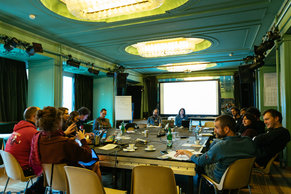
Candor
Some cultures value candor and direct communication. For example, American culture is known for directness and candor. In this context, it is less necessary to read between the lines such that people are more likely to take what you say at face value.Wit
Other cultures, such as British culture, value wit such people often say things they don't directly mean with several layers of communication. For example, self-deprecating humor whereby someone criticizes themselves as a form of humor. This is a type of countersignaling and shouldn't be confused with humility or low self-confidence.Saving Face
Cultures that value saving face avoid direct criticism, rejection and conflict such that minor suggestions can be interpreted as quite negative. For example, telling a salesperson that "you will consider their offer" may actually mean "no."Humility
Cultures that value humble speech view self-praise as arrogant or childish. This can easily be misinterpreted if you're accustomed to a candid culture where self-praise may be perfectly acceptable. Humble speech is not the same thing as humility and members of these cultures may promote their talents and virtues indirectly. For example, in Japan if someone says they "like golf" this actually means "I'm good at golf."Reading the Air
In Japanese language and culture, indirect communication is greatly valued such that direct speech may be considered arrogant, brash or rude. The term for reading between the lines in Japanese is kuuki yomeru, literally "reading the air."Reading Emotion
Using cues such as tone of voice, body language, word selection and facial expression to see the emotion behind words. For example, an angry customer trying to form a logical argument who actually just feels that you haven't shown them any respect such that they feel indignant.Cultural Competence
Cultural competence is the ability to get along with people without depending on a shared cultural background. This certainly benefits from reading between the lines whereby you understand modes of communication such as saving face or wit. Likewise, understanding people with different language backgrounds requires much social intelligence whereby you can read what someone means where language falls short.Interpreting Intent
Reading the intent in social situations and communications. For example, words that could be an insult on the surface that are actually meant to demonstrate a positive intent such as an expression of comradery. For example, if someone asks you about your culture, they may be trying to "other" you by highlighting a difference or they may simply be interested in your culture or they may be interested in trying to build trust with you. In this situation, if you assume negative intent you may be missing out on the true situation.Breaking Rules
Indirect speech is commonly used to break rules to say what can't be said. For example, innuendo designed to harshly condemn someone without actually accusing them of anything. Likewise, terrible biases and negative language can be layered as they aren't acceptable as direct speech. In the context of groupthink, indirect speech may be used to express reasonable opinions that may nonetheless draw the ire of social groups if expressed directly.Passive Aggressive Behavior
Passive aggressive behavior is the poor practice of attacking others without technically doing anything wrong. For example, using sarcasm as an insult.Influencing
Reading between the lines can help you to see attempts to influence your thinking. For example, false praise that isn't intended as admiration but rather to influence your emotions, ideas or actions.| Overview: Read Between The Lines | ||
Type | ||
Definition (1) | The ability to comprehend the true meaning and context of communication. | |
Definition (2) | The ability to understand language and social situations beyond mere literal interpretations. | |
Definition (3) | The ability not to take all speech literally to understand its true intent and meaning. | |
Related Concepts | ||

































